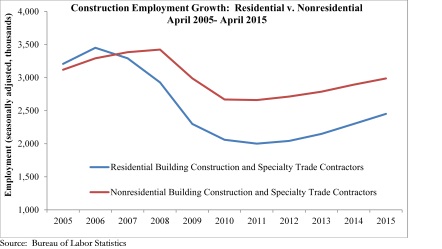A new report from the Bureau of Labor Statistics found that the U.S. construction industry added 45,000 jobs during the month of April. According to Associated Builders and Contractors, nonresidential construction employment rose by 12,400 jobs in April while nonresidential specialty trade contractors added 20,200 new jobs following a loss of 9,000 jobs in March.

The following is a breakdown of construction employment in April:
• Nonresidential building construction employment fell by 7,800 jobs for the month but is up by 16,600 jobs (2.4 percent) from the same time last year.
• The heavy and civil engineering construction segment added 8,400 jobs in April and employment is up by 33,100 positions (3.6 percent) year-over-year.
• Residential building construction employment expanded by 2,800 jobs in April and is up by 41,200 jobs (6.3 percent) on an annual basis.
• Residential specialty trade contractors added 20,800 net new jobs in April and has added 102,400 jobs (6.8 percent) since April 2014.
• Nonresidential specialty trade contractors added 20,200 jobs for the month and employment in that category is up by 76,400 jobs (3.5 percent) from the same time last year.
Mining and logging lost 15,000 net jobs in April after gaining jobs in every month during 2014. This sector lost more jobs during the first quarter of 2015 (-48,000) than it added in all of 2014.
“While the broader jobs report proved better than expected, April was the best month for construction employment since January 2014,” said Associated Builders and Contractors Chief Economist Anirban Basu. “Though it may have been expected to see solid job creation performance reflected in today’s report, it is still a relief to obtain a nice piece of data. Economic data regarding retail sales, industrial production, and other elements of economic life have largely been disappointing to date and the March jobs report fell in line with that series of uninspired results. Data regarding unemployment claims strongly suggested that employers viewed the recent bout of economic weakness as temporary. The lack of new lay-off activity indicates an ongoing demand for labor and April’s reasonably strong employment gains suggest that many employers continue to search for additional staffing."
Related Stories
Building Team | Oct 11, 2022
Associated Materials® Celebrates the Company’s Rich History, Which Began 75 Years Ago with the Founding of Alside
Since its inception in 1947, Alside® has been a leader in innovation and continues this very commitment to excellence – in people, products and services.
Multifamily Housing | Oct 5, 2022
Co-living spaces, wellness-minded designs among innovations in multifamily housing
The booming multifamily sector shows no signs of a significant slowdown heading into 2023. Here is a round up of Giants 400 firms that are driving innovation in this sector.
Fire and Life Safety | Oct 4, 2022
Fire safety considerations for cantilevered buildings
Bold cantilevered designs are prevalent today, as developers and architects strive to maximize space, views, and natural light in buildings. Cantilevered structures, however, present a host of challenges for building teams, according to José R. Rivera, PE, Associate Principal and Director of Plumbing and Fire Protection with Lilker.
| Oct 3, 2022
The College of the Holy Cross completes a $110 million performing arts center
In Worcester, Mass., a one-hour drive from Boston, the College of the Holy Cross has completed its $110 million Prior Performing Arts Center.
Resiliency | Sep 30, 2022
Designing buildings for wildfire defensibility
Wold Architects and Engineers' Senior Planner Ryan Downs, AIA, talks about how to make structures and communities more fire-resistant.
| Sep 23, 2022
High projected demand for new housing prompts debate on best climate-friendly materials
The number of people living in cities could increase to 80% of the total population by 2100. That could require more new construction between now and 2050 than all the construction done since the start of the industrial revolution.
| Sep 23, 2022
Central offices making a comeback after pandemic
In the early stages of the Covid pandemic, commercial real estate industry experts predicted that businesses would increasingly move toward a hub-and-spoke office model.
| Sep 22, 2022
Gainesville, Fla., ordinance requires Home Energy Score during rental inspections
The city of Gainesville, Florida was recently recognized by the U.S. Dept. of Energy for an adopted ordinance that requires rental housing to receive a Home Energy Score during rental inspections.
| Sep 20, 2022
NIBS develops implementation plan for digital transformation of built environment
The National Institute of Building Sciences (NIBS) says it has developed an implementation and launch plan for a sweeping digital transformation of the built environment.
University Buildings | Aug 25, 2022
Higher education, striving for ‘normal’ again, puts student needs at the center of project planning
Sustainability and design flexibility are what higher education clients are seeking consistently, according to the dozen AEC Giants contacted for this article. “University campuses across North America are commissioning new construction projects designed to make existing buildings and energy systems more sustainable, and are building new flexible learning space that bridge the gap between remote and in-person learning,” say Patrick McCafferty, Arup’s Education Business Leader–Americas East region, and Matt Humphries, Education Business Leader in Canada region.

















